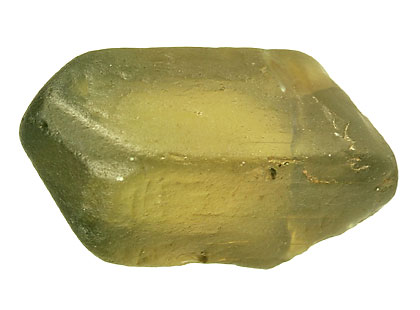Birthstones by the Month
One of The December Birthstones is Zircon

Zircon Gemstone
This a 3.36 ct zircon gemstone shows the aqua blues that can occur in the December birthstone. [2]
Zircon Mineral Form
A member of the silicate family, Blue Zircon grows in a tetragonal crystal structure. Often compared with diamonds, there are distinct differences such as the lower Mohs hardness of 6-7-1/2 and its double refraction. Double refraction means when light enters the crystal and is split into two different rays. Zircon is described as having a brilliant luster when polished. The element Zircon was not isolated until 1789, when Martin Heinrich Kaproth realized there was Zircon in jargon, hyacinth and jacinth.

Zircon and its Many Colors
Zircons are one of the most diverse gems when it comes to color. Vietnam has only recently made a significant impact on the world gem trade producing some very fine Rubies along with some very fine Zircons. Typically one associates Zircon gems with the color blue, but Zircon occurs in virtually every color of the rainbow. [1]
Zircon Facts
Prominent deposits of Zircon are found in Cambodia, Thailand, Australia, Sri Lanka, Tanzania, Nigeria and more. During the middle ages, Zircon was believed to help the wearer sleep better, bring prosperity and promote wisdom. More than just aid in sleep, Zircon was also said to prevent nightmares for a more tranquil slumber. Zircon was valued for other metaphysical properties as well including the ability to bring peace to the wearer as well as riches. Losing your Zircon was said to be a warning of impending danger.

Zircon Wedding Gift
This necklace was a wedding gift for Ellen du Pont Wheelwrigh. In the center of the pendant is a large blue zircon surrounded by canary diamonds alternating with smaller diamonds of various hues, green demantoid garnets, and amethysts. [3]
The characteristics of Zircon
A unique characteristic of Zircon is the weight of the stone. Since zircon is one of the heaviest gems, smaller varieties of Zircon will weigh the same as larger deposits of other gems. Zircon is often misinterpreted as cubic zirconia, especially since it comes in such a wide range of colors. This gem is capable of being naturally white, colorless, blue, red, green, yellow, brown, orange, pink, gray and purple. However, blue continues to be the most popular color, especially when used in jewelry.
Cut and Clarity for the December birthstone
Zircon tends to look pristine to the eye, with zero to minimal inclusions. It is still possible for untreated Zircon gems to have a cloudy appearance, too. There have been rare instances of Zircon containing lengthy parallel inclusions creating a cat’s eye effect. When this cat’s eye effect is present, the Zircon is most often cut into a cabochon. Gem cutters have to be extra careful when cutting and faceting Zircon as the gem tends to be brittle. Zircon even receives its own cut, the zircon cut, which is a modification of the brilliant cut in order to capitalize on the gem’s brilliance while attempting to lower the risk of fracture. The zircon cut has eight extra facets on the pavilion. It’s also common to find Zircon with step cuts or a combination of brilliant and step cuts.
The value of Zircon
While Zircon is sometimes viewed as a cheap diamond simulant, the gem can be valuable for its own merits. 80% of Zircons sold by gem dealers are blue, and the favorite hue is lively pastel. After blue, honey, red and white seem to be the next favorites. Vibrant color is important for increasing value of Zircon, as well as being inclusion free. The value of Zircon does tend to suffer due to its similarity to cubic zirconia, so many people assume it is a lab-grown gem.

Green Zircon
This piece has a very sharp and equant termination, though exhibits slight water worn surfaces characteristic of many gems from the Mogok gem tracts. [4]
Is Zircon ever treated?
Zircon displays such a diverse array of colors sometimes due to trace radioactive impurities. In order to treat Zircon, the radioactive elements are put through a process called metamiction. This process destroys the inner structure. After this process, the Zircon is then heated in order to stabilize the gem for use in jewelry. While not all Zircon has radioactive impurities, heat treating is popular for enhancing color or quality of transparency.
More about Zircon the December birthstone
Due to the brilliant colors of Zircon, especially the ultra-popular blue variety, many glass and crystal companies the world over imitate the colors. Despite being associated with radioactive elements, Zircon is safe to handle and wear. This property also allows the gem to be used in radiometric dating.
The American Gem Society's December Birthstone page has more information to help you buy from knowledgeable and skilled jewelers and to help you make the most informed buying decision.
Image Attribution
- Rob Lavinsky, iRocks.com – CC-BY-SA-3.0 [CC BY-SA 3.0], via Wikimedia Commons
- By DonGuennie - G-Empire The World of Gems - Die Welt der Edelsteine (https://www.g-empire.de/Steine/zirkon.html) [CC BY-SA 4.0], via Wikimedia Commons
- Walters Art Museum [Public domain, CC BY-SA 3.0 or GFDL], via Wikimedia Commons
- Rob Lavinsky, iRocks.com – CC-BY-SA-3.0 [CC BY-SA 3.0], via Wikimedia Commons
- By Parent Géry (Own work) [CC-BY-SA-3.0] via Wikimedia Commons
